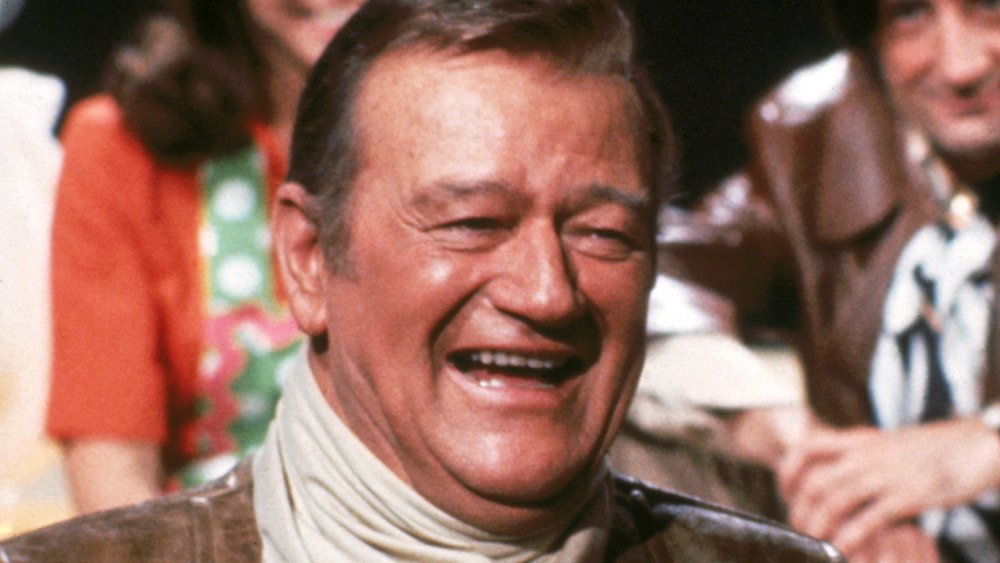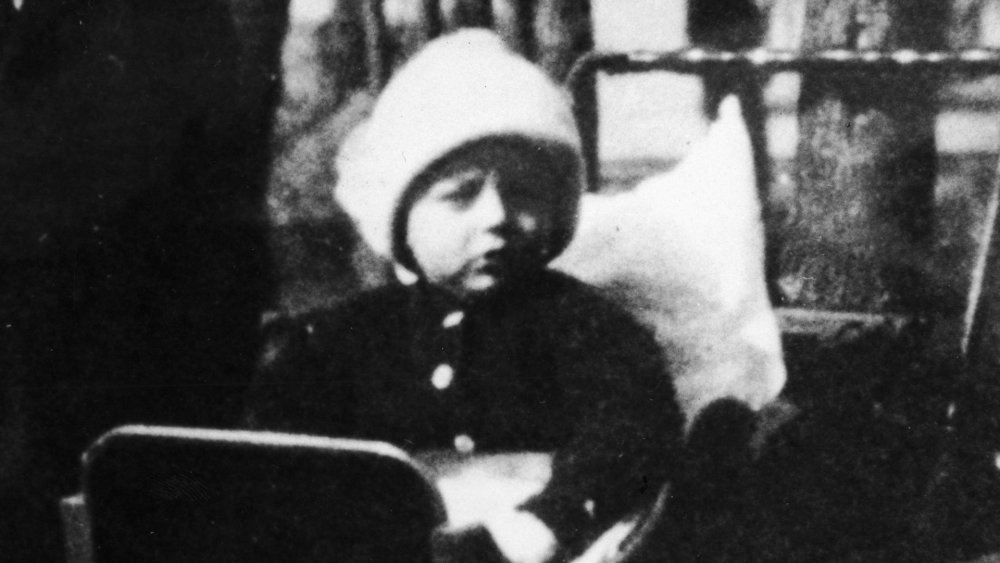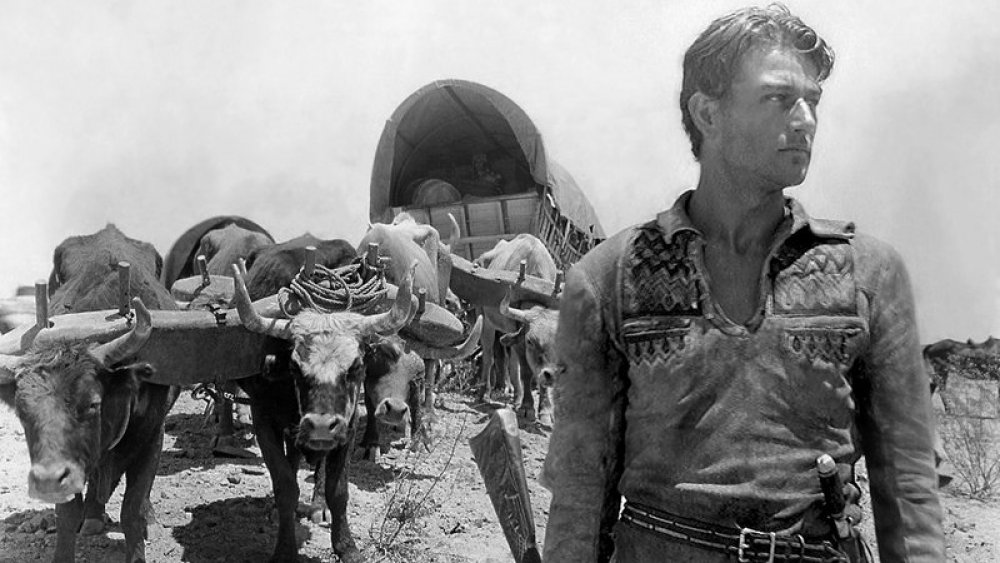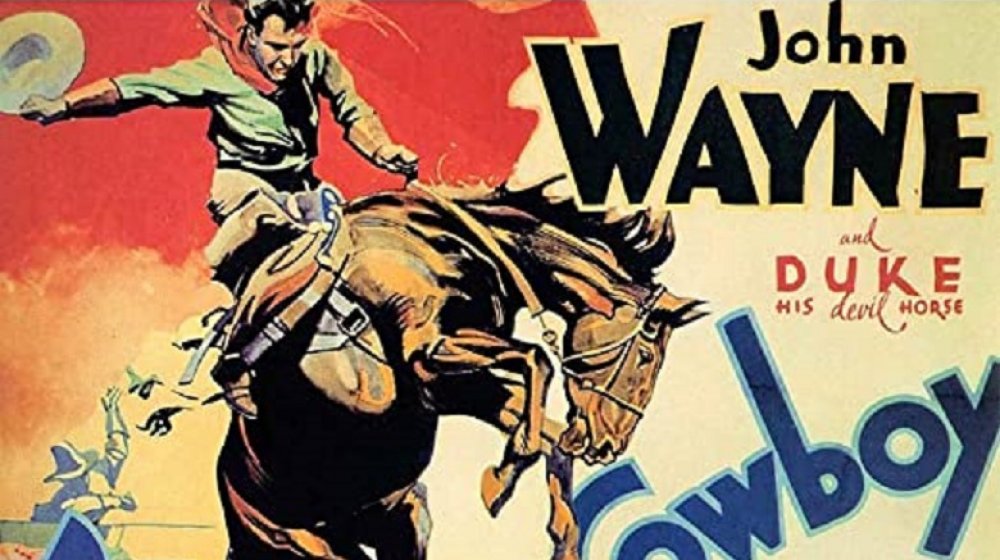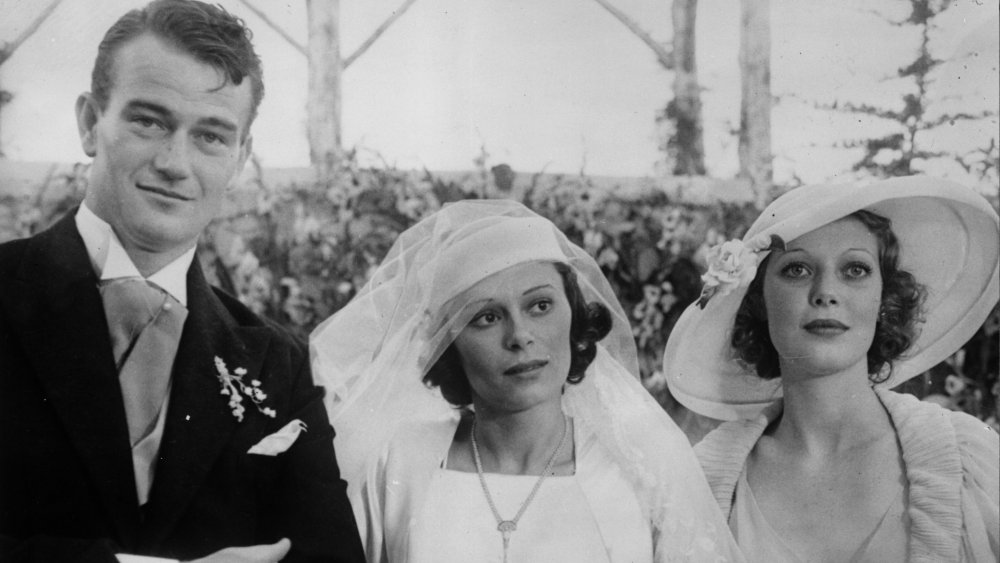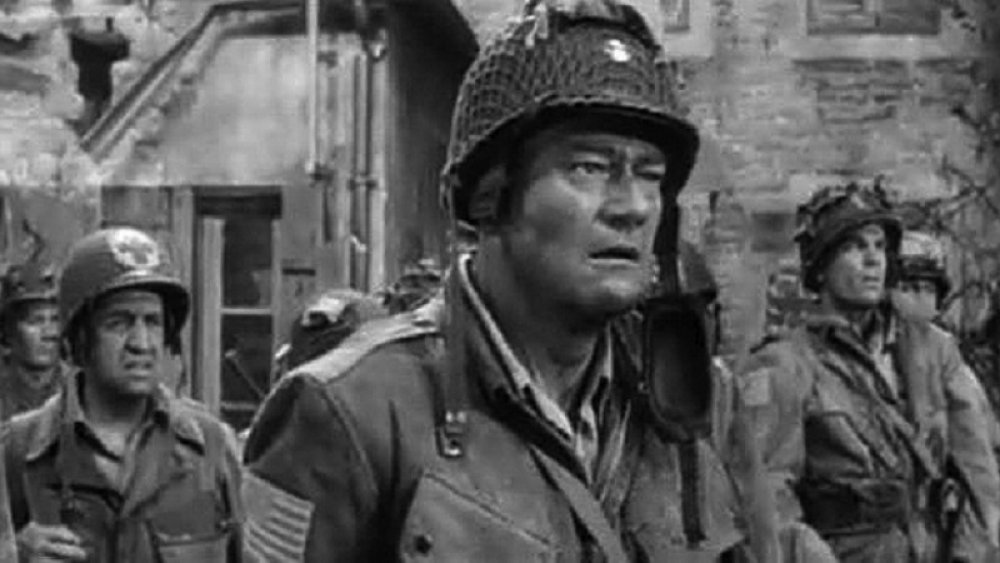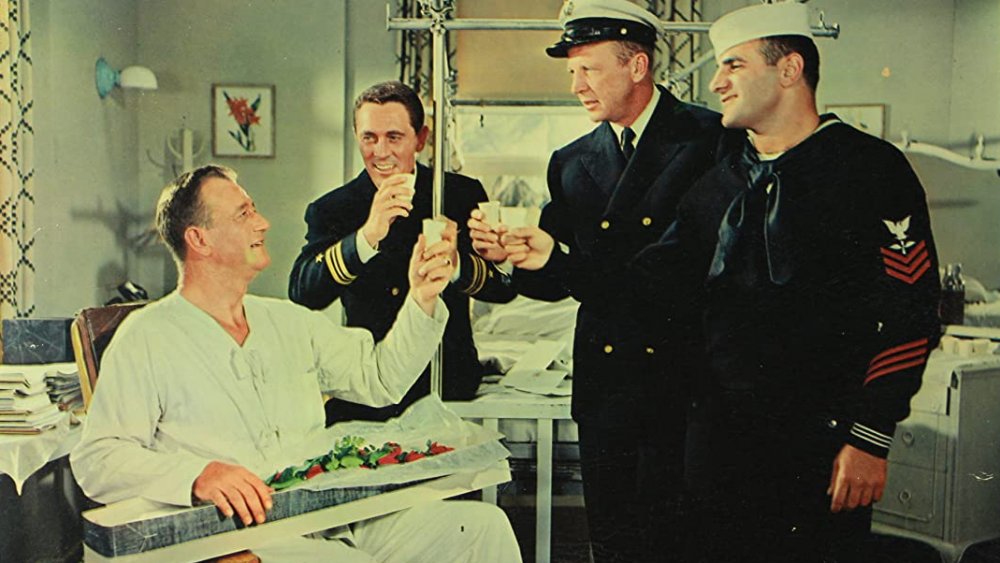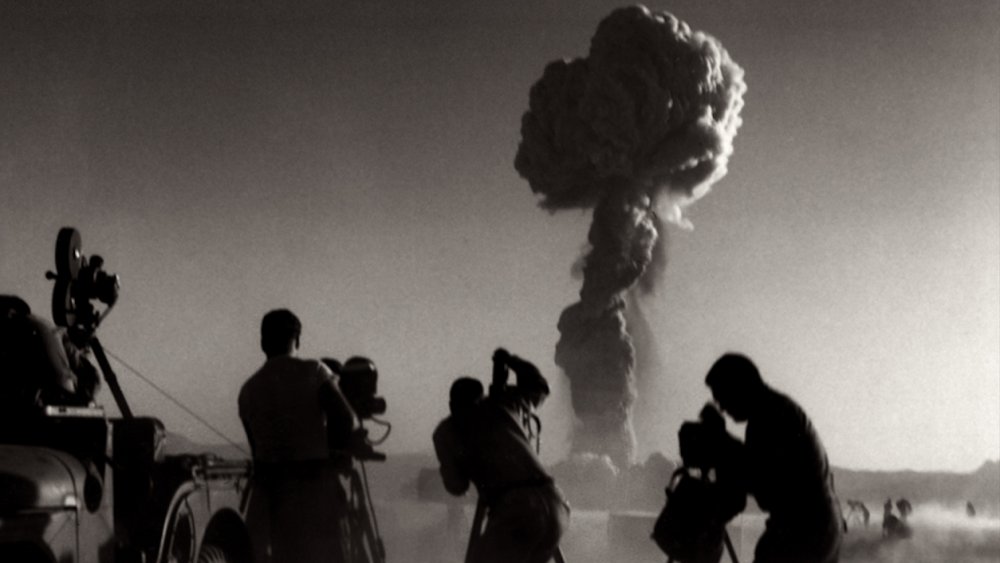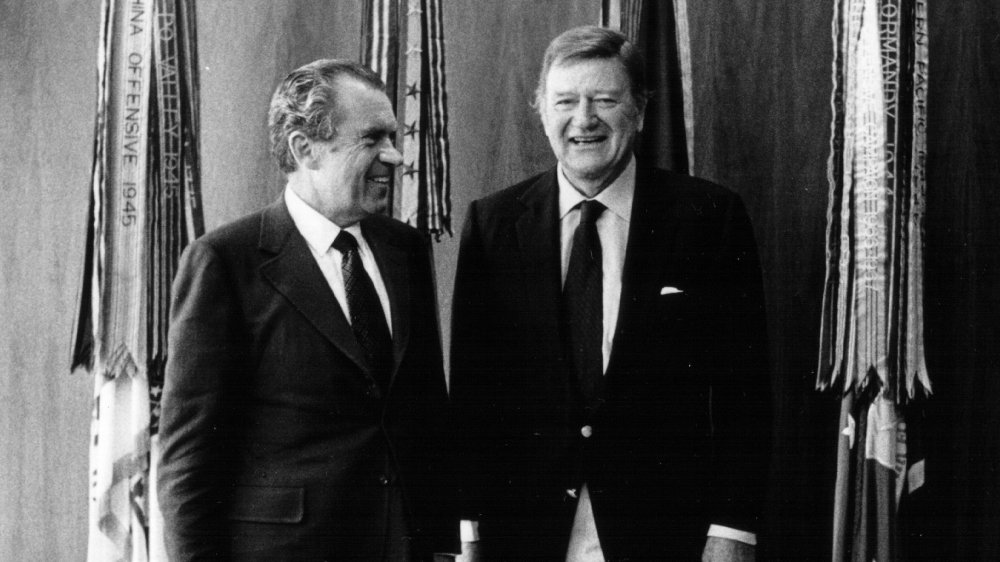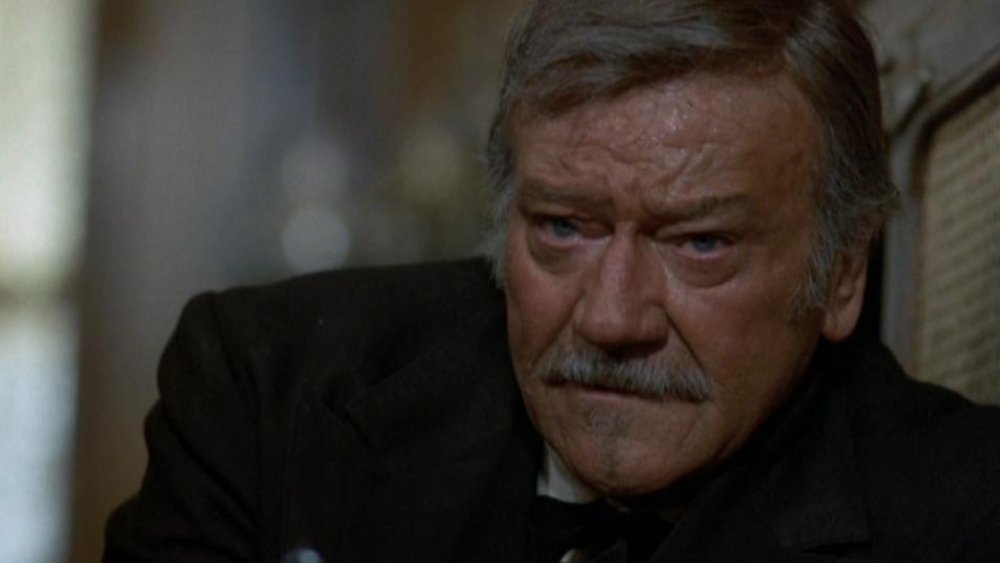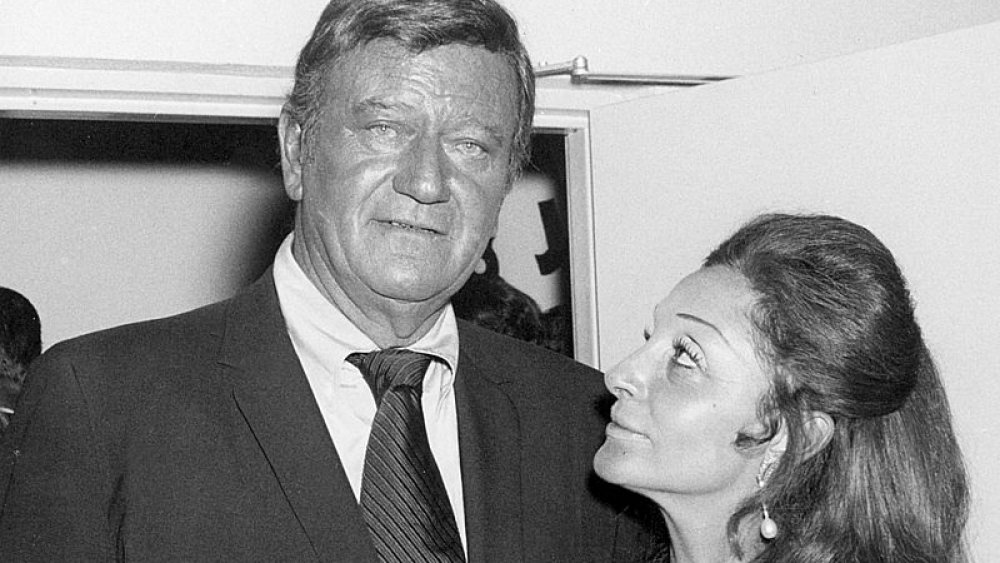The Untold Truth Of John Wayne
Rio Bravo. North to Alaska. True Grit. The Cowboys. This is just a small sprinkling of the 179 movies actor John Wayne appeared in between 1926 and his death in 1979. Over 40 years later, Wayne remains an American icon for his roles in Westerns and war movies. Dozens of books have been written about Wayne and his illustrious career, which spanned exactly 50 years, according to the Internet Movie Database. He was, according to almost everyone, a family man dedicated to his roles in Westerns and war movies throughout his career.
But what do we really know about John Wayne? It turns out there are some tantalizing tidbits about his life which contributed heavily to his career, personal, and even public choices. But Wayne was a private man who, according to Factinate, announced in his early years, "I'm Duke Morrison, and I never was and never will be a film personality like John Wayne." Read on for some little-known information on the legendary film star.
John Wayne, the early years
Born Marion Robert Morrison in 1907 in Iowa to a pharmacist and his wife, John Wayne came west with his family to California in 1914. Biography verifies that the boy's closest companion was his little dog, an Airedale named Duke. The two were so inseparable that they became known as "Little Duke" and "Big Duke," and a nickname was born. At Glendale High School, Wayne especially excelled at football, as well as theater. Little did the boy know that both his nickname and his early acting would be the keystones to his career.
At first, Wayne believed he was destined for a career in football. He played so well that he received a scholarship to play for the University of Southern California Trojans. Wayne became a star player, and in his leisure time, he was a typical surfer dude at nearby Newport Beach. Unfortunately, his surfing pastime, his budding football career, and his college pursuits ended in 1926, according to the Chicago Tribune, when Wayne was injured in a bodysurfing accident. Upon leaving school, John Wayne Heritage says that Wayne began working for local movie studios.
John Wayne went from prop man to leading man
Wayne's first job in the film industry was at Fox Film, according to John Wayne Heritage. He worked as a prop man. It was a menial job, shoving furniture and equipment for low wages, but it was a living. Wayne was also able to serve as an extra in several films beginning in 1926, his first role being an anonymous Yale football player in Brown of Harvard. He would play 13 more uncredited roles before he finally received notice, as Duke Morrison, in 1929's Words and Music. He also met director John Ford, with whom he formed a friendship for life. But it was director Raoul Walsh who finally gave Wayne his first big break in The Big Trail, playing Breck Coleman, who leads covered wagons west on an overland trail.
Washington, DC's, Evening Star would verify that Wayne auditioned against 81 other actors before winning the role. The paper also noted Wayne's former football career and named him as "an assistant property boy." Notably, the name "John Wayne" had appeared for the first time in print. John Wayne (a blog) explains that Walsh suggested the name Anthony Wayne. Fox Studios boss Winfield Sheehan thought it sounded too Italian and suggested John Wayne instead, which both Sheehan and Wayne readily agreed to. As stated by John Wayne Heritage, "It was OK with him if the people paying his salary wanted to spruce up his name."
I don't get on a horse unless they pay me.
John Wayne did not like horses, according to his biographer, Scott Eyman. In his book, John Wayne: The Life and Legend, Eyman says that Wayne's own son, Michael Wayne, learned to ride horses from stuntmen, not his father. John Wayne? Didn't like horses? That's a hard pill to swallow, considering that the Duke spent some of his childhood and much of his career atop a horse. And Eyman isn't the only one to say that the Duke disliked horses. The New Frontier details a PBS interview with David Gergen and Garry Wills, during which Gergen says, "You say that he hated horses, a man..." and Wills responds, "Hated horses. Never rode except on the set, and never rode when he didn't have to."
On the opposite side of the spectrum, John Wayne's son, Patrick, told author Tony Medley that his father "was a terrific horseman." During the filming of 1971's Big Jake, Patrick Wayne watched as the equestrian-savvy Duke stayed astride his horse even after it spooked during a chase scene. He also recalled a time when he himself was being filmed for The Comancheros and, "I looked awful. It looked like I didn't know what I was doing riding the horse." Afterward, Patrick's father told him, "You're going to learn how to ride a horse," and made sure he received additional lessons. In the end, said Patrick, "I looked very good."
John Wayne was married three times
Onscreen, John Wayne's persona was that of a tough, rugged, handsome man, the stuff of Hollywood fanzines. Off-camera, The Fashion Ball says the Duke was somewhat reserved, even awkward, when it came to women. Wayne said he never chased women, according to critic Emanuel Levy, and screenwriter James Grant claimed that "pushy dames really scare him." Yet Wayne married three times, producing seven children. Wife number one was Josephine Saenz (pictured above, center), whom he married in 1933. Four children (Michael, Toni, Patrick, and Melinda) came of the union. The marriage ended in 1943, perhaps due in part to Wayne's starring role and alleged affair with Marlene Dietrich while filming Seven Sinners in 1940 and The Spoilers and Pittsburgh in 1942, says Newt's John Wayne Site.
Most biographers blame Dietrich for the affair, which began shortly after she saw Wayne for the first time and purportedly commanded her agent, "Daddy, get me that." With a contract in place, the exotic German actress seduced the Duke. The affair lasted roughly three years, after which Wayne married a second time, to Esperanza "Chata" Baur Diaz. The union was fraught with jealousy, Wayne's alleged affair with actress Gail Russell, and drunken fights, says Emanuel Levy. The day their divorce was final in 1954, Wayne next married actress Pilar Palette. Three more children (Aissa, John, and Marisa) were born before the couple divorced in 1973. Wayne remained single, although he did live his last years with his secretary, Pat Stacy.
Was the Duke a draft dodger?
Between 1940 and 1945, according to the Internet Movie Database, John Wayne's movies included seven about war: Dark Command, The Long Voyage Home, Flying Tigers, The Fighting Seabees, Back to Battaan, Reunion in France, and They Were Expendable. How did he film these movies while World War II raged on? The answer is that although he dutifully registered for service (as Marion Mitchell Morrison), Wayne received a 3-A deferment for "family dependency," says Den of Geek. As a father and sole provider for his family, Wayne wanted to "do a few more movies" before entering the service. And there is little doubt that he wanted to keep his name fresh in Hollywood, too. He did, however, expect to eventually go to war.
But John Wayne never ended up serving in the Second World War. In 1942, Congress revised the Selective Service Act to defer all married men until further notice, according to World War 2.0. "We want the unmarried men taken first," said Senator Joshua B. Lee, explaining that "the family is the fundamental unit of organized society." Dependency deferments, according to Encyclopedia.com, "enjoyed especially strong support." Although Congress would agree and disagree throughout the war, Wayne remained immune from service. Magellan Times claimed that this annoyed his friend, John Ford, greatly — to the extent that during the filming of They Were Expendable in 1945, he barked, "Duke, can't you manage a salute that at least looks like you've been in the service?" Wayne allegedly stormed off the set.
John Wayne wore a rug
In 1948, when John Wayne was 41 years old, a look in the mirror told him what many middle-aged men dread: He was progressively losing his hair, a condition which had gradually become noticeable in his World War II-era movies. The Vintage News states that from that time on, Wayne wore a toupee in his films, although he was occasionally seen in public without it. He was also quite open about wearing a rug. Mental Floss confirms that when a reporter asked about Wayne's "phony" hair, he quipped, "It's not phony. It's real hair. Of course it's not mine, but it's real." Notably, he did make one exception, declining to wear his wig for The Wings of Eagles in 1957.
As it turns out, the fake hair from a man's head can be worth a bit. In 2010, the BBC reported that the toupee Wayne wore during the 1967 movie El Dorado was going up for auction. It ended up fetching $1,244. In 2013, another custom-made toupee for Wayne was found. This one was made of human hair and was even "tied one strand at a time to a lace mesh with silk bands in the interior to make the appearance of a scalp." Vintage News reported that the wig, along with its canvas block, sold for $6,250. As for the "real" John Wayne, bloopers in 1949's The Fighting Kentuckian, 1952's The Quiet Man, and 1960's North to Alaska each show fight scenes during which John Wayne accidentally flipped his wig.
John Wayne was exposed to radiation in 1954
In 1954, Wayne was in the Utah desert shooting The Conqueror, a movie about Genghis Khan which The Guardian concluded was not a good fit for the actor. More important was the fact that the film shoot was taking place 100 miles from an atomic bomb testing site in Nevada. Officials assured everyone that fallout could not possibly reach the filming site, although a Geiger counter on the set "crackled so loudly Wayne thought it was broken." Nobody knew it at the time, but everyone on the set had been exposed to radiation as the fallout was blown south and east. People like them are now referred to as "Downwinders," who were exposed not just in Utah, but also Arizona and Nevada between 1951 and 1962.
Biography confirms that Wayne first came down with cancer in 1964, losing a lung and some ribs to the disease. He would eventually die from stomach cancer in 1979. His sons who were on the set, Michael and Patrick, also got cancer but survived. By 1981, The Fashion Ball reports, 91 of the 220 cast and crew members on the set of The Conqueror had developed cancer. Forty-six of them, including Wayne, lead actress Susan Hayward, and director Dick Powell, had died. Had they lived longer, the victims would have seen the establishment of the Radiation Exposure Compensation Act of 1990, which pays cancer victims between $50,000 and $100,000 — if they can provide proof they were affected by government-caused radiation exposure.
John Wayne, the conservative Republican
John Wayne was friends with Presidents Dwight Eisenhower, John Kennedy, Lyndon Johnson, Richard Nixon, Gerald Ford, Jimmy Carter, and Ronald Reagan. Far beyond just being a voter, Wayne actively became friends with these men. He was especially supportive of Nixon, whom he rallied for in the 1960 presidential election, according to the Nixon Foundation. But Wayne also was a good sport. When JFK won the presidency, he received a telegram from Wayne expressing "congratulations from the loyal opposition." And when Kennedy was assassinated three years later, Wayne was as devastated as anyone.
Indeed, Wayne's feelings about politics were fair. When Barry Goldwater lost the 1964 election, Wayne again bowed to the loss. But when the chance came to vote for Nixon again in 1968, Wayne once more became a huge supporter, and friend. It was reciprocal — Nixon appreciated that Wayne had a way with the blue-collar voters. After Nixon won the election, the two remained good friends — even when the president became embroiled in the infamous Watergate scandal and subsequently resigned in 1974. Ironically, John Wayne Enterprises and John Wayne Cancer Foundation founder Aissa Wayne (John Wayne's daughter) was said to have "overstepped the boundary" when she endorsed Republican nominee Donald Trump in 2016. Yahoo! News confirmed that Aissa's brother, Ethan, curtly told the press that, "No one can speak on behalf of John Wayne and neither the family nor the foundation endorses candidates in his name."
John Wayne's final film: The Shootist
In 1976, John Wayne appeared on the big screen for the last time. Ironically, the film, The Shootist, which co-starred Lauren Bacall and Ron Howard, was about an aging Old West gunman who was dying from cancer. After Wayne's character, J.B. Brooks, is diagnosed as terminal, he chooses to meet his maker in a gunfight instead. Although the film was deemed stagnant by some critics, John Wayne Heritage heralds it as being "among his greatest performances." That may be, but because Wayne himself had battled cancer, the general public assumed that he still had it during shooting. We Are the Mutants notes that Wayne was indeed "obviously ailing" during filming, which was characterized by the fictional Brooks grunting and groaning as he moved around.
In truth, according to the Internet Movie Database, Wayne did not have cancer during filming, having kicked his illness back in 1969. He did, according to Scott Eyman, have a bout with stomach cancer in 1975, but it had gone into remission before The Shootist was filmed. On the set of The Shootist, he also was hospitalized with a bad case of the flu, but Wayne showed no signs of slowing down. According to Medium, the actor actually had another movie on the table titled Beau John. The film was intended as a "light comedy" about the patriarch of a Kentucky family during the 1920s. Unfortunately, Wayne's stomach cancer returned in January 1979, and he died on June 11.
John Wayne was posthumously accused of racism
In 2019, a 1971 interview of Wayne in Playboy (via Shanti Pages) resurfaced. In it, Wayne said, "I believe in white supremacy until the blacks are educated to a point of responsibility." He also voiced belief that blacks needed better education opportunities, that the slavery of long ago was not our generation's fault, and that taking American land from indigenous people was a matter of survival. Mercury News' David Whiting revisited the article, writing that Wayne (pictured above with his wife, Pilar, in 1971) "was, by his own admission, a 'white supremacist.' " He also posed the question of whether the name of John Wayne Airport in Orange County, California, should be changed.
But was Wayne really claiming to be a white supremacist, or was his statement just badly worded? In a second article by Whiting in the Orange County Register, readers were supportive of Wayne. One Hispanic man called the article "another example of white self-loathing." Another reader opined that " 'Political Correctness' is holding America hostage." Yet another pointed out that "calling [Wayne] a white supremacist, with today's connotation, is totally unfair. He was a child of his times." CNN quoted Wayne's son, Ethan, as saying, "It would be an injustice to judge someone based on an interview that's being used out of context. [...] So any discussion of removing his name from the airport should include the full picture of the life of John Wayne and not be based on a single outlier interview from half a century ago."
